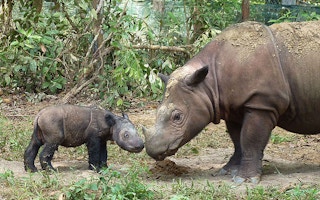Research has shown that a sixth mass extinction event is underway and largely driven by human activities. With the global population set to balloon to 10 billion people by 2050, which will more than double the current demand for food and water, scientists are increasingly calling for mankind to set aside sufficient amounts of ecosystems on land and at sea to ensure the survival of the many species with which we share planet Earth.
Yet, according to Jonathan Baillie, Executive Vice President and Chief Scientist of the National Geographic Society, and Ya-Ping Zhang, Vice President of the Chinese Academy of Sciences, “Current levels of protection do not even come close to the required levels.”
Baillie and Zhang note in an editorial published in the latest edition of Science that less than half of the ecosystems on Earth’s surface remain relatively intact (and that these areas tend to be less productive lands), while just 3.6 per cent of Earth’s oceans and 14.7 per cent of land area has been accorded some sort of protected status. “Most scientific estimates of the amount of space needed to safeguard biodiversity and preserve ecosystem benefits suggest that 25 to 75 per cent of regions or major ecosystems must be protected,” they write.
The fact that there is such a wide range to scientists’ recommendations — from 25 to 75 per cent — demonstrates just how much uncertainty there is around how much of Earth we should protect. It’s difficult to determine exactly how much space we’d need to set aside in order to preserve current levels of global biodiversity thanks to our limited knowledge of the species and ecosystems we share this planet with — especially in the context of unprecedented threats such as climate change. However, the greatest risk, Baillie and Zhang write, would be to protect too little of the planet to give our fellow Earthlings a fighting chance:
“Simply put, there is finite space and energy on the planet, and we must decide how much of it we’re willing to share. This question requires deep consideration as it will determine the fate of millions of species and the health and well-being of future generations. … [T]argets set too low could have major negative implications for future generations and all life. Any estimate must therefore err on the side of caution.”
The governments of the world came together in 2010 at the Nagoya Conference of the Convention on Biological Diversity and adopted 20 Biodiversity Targets, what are commonly referred to as the Aichi Targets. The 11th Target sets the goal of conserving at least 17 per cent of terrestrial areas and inland waters, as well as 10 per cent of coastal and marine waters, by 2020. Baillie and Zhang argue that these goals “would be woefully inadequate for the task” of ensuring we achieve other Aichi Targets, such as Target 12, which aims to prevent the extinction of known species, and Target 14, which promotes the protection of ecosystems that provide essential services like clean water and carbon sequestration.
“
If we follow the Half-Earth call to action and protect 50 per cent of our lands and seas, we’ll safeguard at least 85 per cent of species and reverse this crisis.
E.O. Wilson, founder, Half-Earth Initiative
To preserve global biodiversity and safeguard the provision of critical ecosystem services, ambitions must be ratcheted up in 2020, when the world’s governments will meet at the Convention on Biological Diversity in Beijing, China to set biodiversity targets for the future, Baillie and Zhang write:
Given the evidence to date and the implications of an underestimate, we encourage governments to set minimum targets of 30 per cent of the oceans and land protected by 2030, with a focus on areas of high biodiversity and/or productivity, and to aim to secure 50 per cent by 2050. This will be extremely challenging, but it is possible, and anything less will likely result in a major extinction crisis and jeopardise the health and wellbeing of future generations.
Baillie and Zhang have been joined by other distinguished scientists and conservationists in urging world leaders to commit to the level of protections needed to avert the collapse of global biodiversity. Renowned biologist E.O. Wilson, for instance, is the founder of the Half-Earth initiative, which is also calling for 50 per cent of Earth’s ecosystems to be protected. (You can listen to Wilson discuss the Half-Earth initiative on the Mongabay Newscast).
“If we follow the Half-Earth call to action and protect 50 per cent of our lands and seas, we’ll safeguard at least 85 per cent of species and reverse this crisis,” Wilson said in a statement. “We must work together to learn more about Earth’s species and move quickly to protect them before they disappear forever. I encourage the world’s governments to commit to conserving at least half the Earth.”
Preeminent conservation biologist Thomas Lovejoy, known as “the Godfather of biodiversity,” echoed that call, saying: “This is the level of ambition we need because this is the last chance to secure a functional living planet for people and other forms of life.” (You can listen to Lovejoy discuss why it’s time for humans to start managing the entire planet as a system on the Mongabay Newscast.)
Added Wilson: “To strive against the odds on behalf of all life would be humanity at its most noble.”
This story was published with permission from Mongabay.com. Read the full story.










